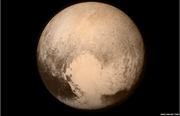Dwarf Planets are planetary-mass objects that do not dominate their region of space (meaning that they have not cleared the neighborhood around their orbit of other objects) and are not satellites of other objects. Examples of dwarf planets are Pluto and Ceres.

Pluto as seen by the New Horizons probe in 13 july 2015, right before its flyby on the dwarf planet.
Terraforming Dwarf Planets[]
Terraforming dwarf planets could be a problem. It is difficult to get dwarf planets to hold an atmosphere and they are far away from the Sun. However, their abundance of ice makes paraterraforming a possibility. Dwarf planets would need worldhouse domes to keep their atmospheres enclosed. A great heat source would be needed and it would have to be stable. Some dwarf planets are just rocky while others have ice. The rocky ones would need a bombardment of water-ice comets, while icy bodies would need the ice to be melted.
Protection from Solar Winds and Cosmic Radiation[]
Dwarf planets do not have magnetic fields to help protect against radiation. This protection would need to be added artificially, e.g. as a function of the wobrldhouse.
Sunlight and Heat[]
Most dwarf planets recieve too little sunlight. This would be a problem for plant growth. Solar mirrors would take in the rays and redirect it to the dwarf planet, warming it.
Entering and Leaving a Terraformed Dwarf Planet[]
Travel to and from a paraterraformed dwarf planet could prove to be a problem, due to the worldhosue being in the way. If the worldhouse was damaged, heat and atmosphere would be lost. Assuming that teleportation is impossible, one could set up airlocks in the worldhouse for travelers to use.
Preventing Asteroid Impacts[]
Asteroid impacts could create large holes in the worldhouse, rapidly destroying the biosphere inside. A paraterraformed dwarf planet would need a system for detecting and diverting dangerous asteroids.
Sulfur Hexaflouride[]
Sulfur Hexaflouride is the most powerful greenhouse gas. Lots of these greenhouse gases would be needed due to the far off distance from the sun. Life would need to adapt to potentially high levels of sulfur hexaflouride. The outermost Kuiper Belt objects would need the most sulfur hexaflouride, at an atmospheric concentration of 0.5%.
Artificial Gravity[]
The dwarf planets all have extremely weak gravitational fields. Low gravity would probably be extremely difficult for any of Earth's plant and animal life to adapt to. In theory, one could increase the gravity of a dwarf planet by adding mass to it: a heavy metal such as iron would be useful for this purpose. Alternatively, plants and animals could be modified to survive under low gravity.
Rocky Dwarf Planets with no Ice[]
Dwarf planets with no ice could be terraformed by sending ice-rich comets to bombard the low-elevation areas, creating seas and lakes.
Introduction of Life[]
Life would be introduced after a dwarf planet has been terraformed. The first life would be microbes such as bacteria, algae and single-celled fungi, which would convert rock into soil and begin changing the composition of the atmosphere. Next would be plants and simple animals. Once conditions have stabilized, humans would be introduced as the final life forms.
Terraforming Candidates[]
Pluto[]
Pluto's surface is mainly composed of nitrogen and methane ice, though there is water ice in the mountains and beneath the surface. Melting and vaporizing the ice would create a nitrogen- and methane-rich atmosphere, leaving behind a water ice surface. This could be further melted to produce an ocean of liquid water. Oxygen would need to be added to the atmosphere, and methane removed. A world house would be needed to keep the atmosphere in. Artificial islands would be built floating in the ocean to serve as living space.
Charon[]
Charon's surface is mainly water ice, unlike Pluto. This could also be melted to form an ocean. Beyond this, paraterraforming would be similar to Pluto.
Eris[]
Eris has methane and water ice. After heating and enclosing the atmosphere, the methane would be converted into CO2 and oxygen. If Eris has any rock for islands, then that is where the first introduced life will be at. If Eris ends up having an endless water ocean, artificial islands and continents would have to be built in the ocean.
Ceres[]
Ceres is one of the best potential candidates for terraforming. Creating the enclosing the atmosphere, adding an artificial heat source, and building artificial continents would probably be needed.
Makemake[]
Paraterraforming of Makemake would likely be similar to that of Pluto. However, Makemake is notable for having less nitrogen than Pluto.
Haumea[]
Haumea's rotational speed is too high - about 3-4 Earth hours. The first thing that should be done is to slow down to about 20 hours at the very least. Paraterraforming of Haumea would likely be similar to that of Pluto.
The Kuiper Belt[]
There are over 70,000 minor planets (dwarf planets are a type of minor planet) that may exist in the Kuiper Belt. They have rich amounts of ice, but all of these new atmospheres would have to be enclosed, and due to the distance from the Sun, a major heat source would need to be added.
Sedna[]
Sedna's surface is mainly water ice, unlike Pluto and Charon. This could also be melted to form an ocean. Beyond this, paraterraforming would be similar to Pluto and Charon.
The Oort Cloud[]
There are over 1 trillion comets that may exist in the Oort Cloud. They have rich amounts of ice, but all of these new atmospheres would have to be enclosed, and due to the distance from the Sun, a major heat source would need to be added.